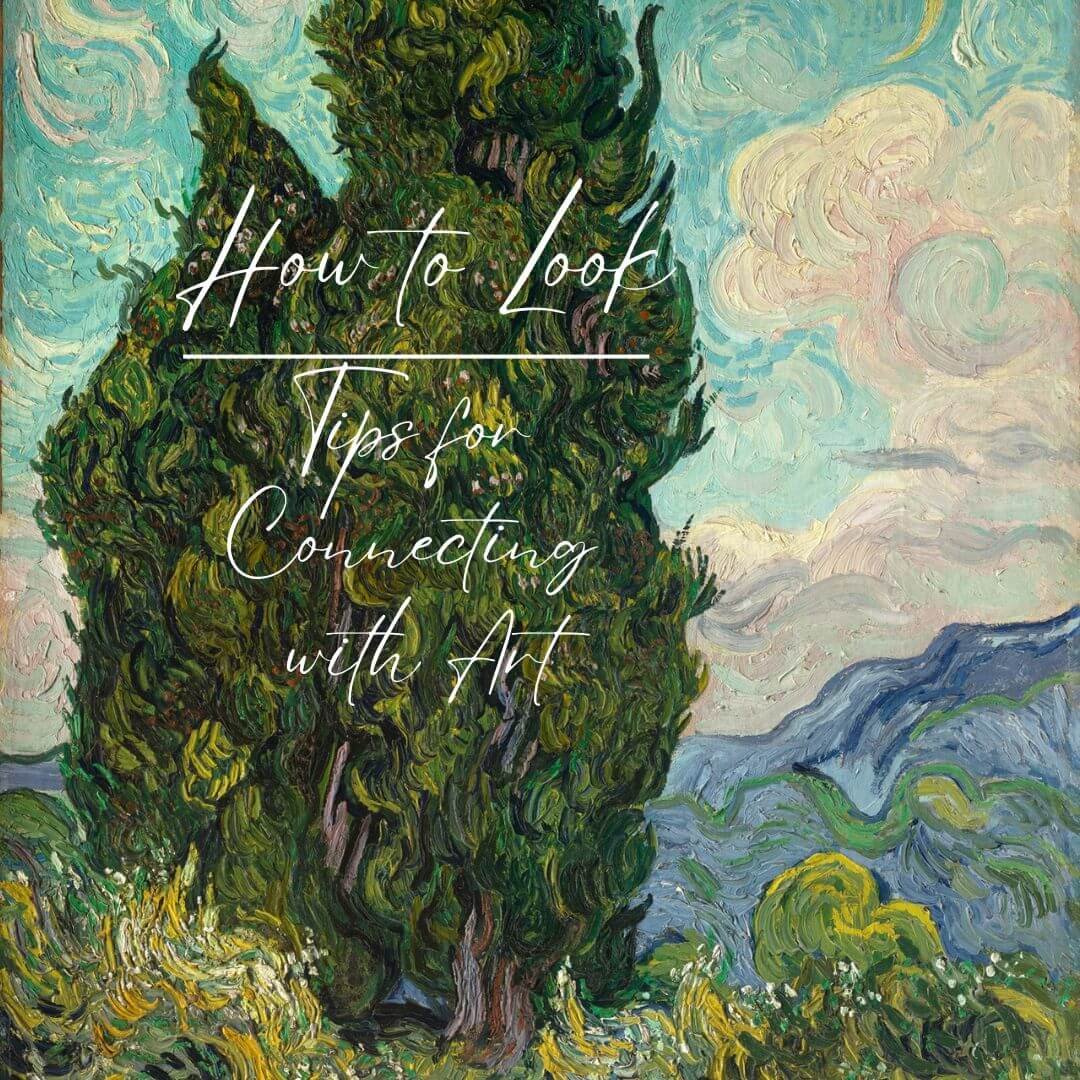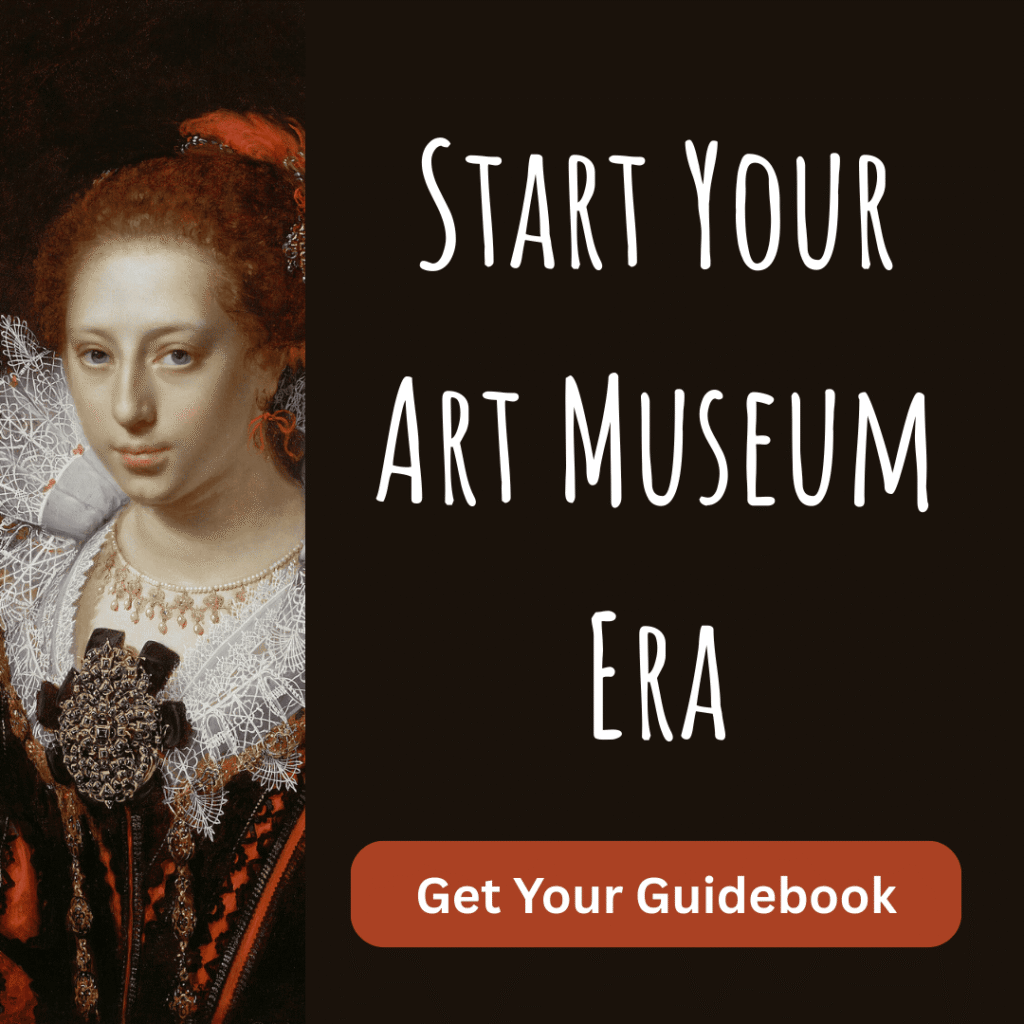Cover image: Vincent Van Gogh, Cypresses (detail), 1889. Metropolitan Museum of Art, New York.
Try these tips, techniques, and challenges to help you connect with art in museums, galleries, and other places where you can see art in person. (For games and activities that you can do at home, check out the art appreciation activities handout.) All of these ideas build off the important skill of active looking, the ability to look closely and attentively at art for a prolonged period of time, so you might want to review that skill before starting.
Ways of looking
- Many experts say you only start to understand an artwork once you’ve looked at it for five minutes straight. Give it a try and see how your experience changes over that time. (I mean really look at it; don’t just stand there and stare at it while your mind is somewhere else.) Can you come up with five things you noticed by the end that you hadn’t originally?
- If five minutes feels like too much for you, try to stay with the artwork at least long enough to discover one new thing. It could be something simple, like a painted shadow or reflection, that you didn’t notice at first glance.
- Look from multiple viewpoints. Start at a comfortable viewing distance, depending on the space and traffic, but feel free to move around as necessary. Most art is best appreciated when seen from multiple vantage points, and many three-dimensional artworks are meant to be viewed in the round.
- Check out what catches your eye and go from there. Good compositions are designed to direct your eyes through all the important points, so just take your time and let your focus travel naturally. If you really want to make sure you’ve seen everything, you can also briefly scan the whole image.
- Find at least one artwork that makes you see something ordinary in a new way.
Search for details
Looking for details is a great way to heighten your perception and immerse yourself in the world of each artwork. In particular, characteristics like texture and size don’t really come through in photographs, so it’s a great idea to pay attention to them when you see art in person.
- Start with the overview, then check out the details. After taking in the work as a whole, shift your focus to details you’ve noticed during your scan or continue to look for new ones. I call this “hunting for Easter eggs”, since it can turn up the most unexpected and delightful stuff.
- Look for signs of the artist at work. One of the most compelling details in any artwork is how the artist applies the paint, draws the lines, carves the stone, etc. Paying attention to individual marks, brushstrokes, or lines can give a very different feeling from the work as a whole. As you can see from the cover image, the works of Vincent Van Gogh might be among the few exceptions; you can definitely see his textural brushstrokes in the image.
- Notice the surface. Is it bumpy or smooth? Glossy or dull? Made of one medium or several? The surface of an art object is something that you can only see in person, so it’s definitely worth checking out, especially in three-dimensional works. You might enjoy guessing the medium and techniques used based on the surface appearance and then checking yourself by reading the wall text.
- Notice the size relative to you and to the works around it. Scale can tell you a surprising amount about a work. A huge painting might tell you that its subject was considered extremely important, or that the artwork was meant for display in a massive building. A tiny work might have been meant to be carried with its owner, or it might reflect the intricacy of the craftsmanship in its details. Like texture, it doesn’t really come through in photographs.
- As you move through the museum or gallery, look for plants and animals in all the art you see. You might be surprised to find that they’re everywhere! The challenge is to find not just the obvious ones that are front and center, but also those in the backgrounds, used as decoration, on furnishings, half hidden, and more. Notice how many different ways there are to depict the same species and how many ways they can be used in art.
- Here are some other things you can look for across the entire museum: How many different animals can you find in the art? How many seasons and types of weather? Climates? Fruits and vegetables? Flowers? Other food? Find a place you’d want to visit on vacation. An interior you’d want to live in. An interior you definitely wouldn’t want to live in. Be creative in finding these things. Don’t just look in paintings. What can you find in a tapestry of porcelain vase, for example? What is the strangest creature you can find?
Engage and interpret
- Come up with a story about what’s going on in an artwork. Make sure it’s based on the details you observe in the piece. The more creative, the better. There’s no need to get the “right” interpretation. If you’re museum visiting with a friend, it can be fun to compare stories or create one together.
- Stand in front of an artwork and think about how you would describe it to a friend who hasn’t seen it. Fancy art terms aren’t necessary; it’s better to use words anyone would understand.
- Step into the shoes of a figure depicted in an artwork. Imagine what they are seeing, thinking, and feeling. What is their life like? How do they feel about their place in the artwork? Notice if doing this helps you connect to these people and empathize with them. The obvious artworks to choose for this would be portraits, but challenge yourself to also spend time with people in less prominent positions within the compositions.
- Imagine being the artist. Think about seeing the world the way they did, the choices the artist made to create this specific artwork, and what the process of actually making it (physically and intellectually) might have been like.
- Imagine that you’ve stepped inside the scene depicted in an artwork and name all the different things you can see, touch, hear, smell, and taste. Try to imagine each sensation in as much detail as you can. Some sensory categories will be more difficult than others; try to find at least one thing for each. This is easiest in representational artworks with lots of detail, especially landscape and still life paintings. But you could also be more imaginative and try it with abstract artworks or objects. What would the shapes and colors in an abstract painting sound and smell like, for example?
- Ask yourself some of these questions: What features stand out most to you in this artwork? What perplexes you about it? What intrigues you? What do you want to know more about? How does this artwork make you feel and why? What aspects feel familiar or relatable to you? What feels unfamiliar? The point is to get you thinking, not to come up with definitive or “correct” answers.
- Read the information on the wall label, then look closely at the artwork again and see what you can notice to support what’s written on the label. Do you notice anything different or does your interpretation change with this new information?
Discover your taste
- Notice which artworks especially appeal to you. Do they have anything in common – color, mood, style, time period, subject matter, etc.? As you move through the museum, see if other artworks with those same characteristics – but maybe also some key differences – also resonate with you. Why or why not?
- There’s a school of thought that believes we are attracted to the artworks that give us something we are lacking.1 For example, a tranquil and balanced artwork might appeal to someone with a busy and chaotic life. When you find yourself attracted to an artwork, ask yourself what it provides that you need. You might learn something about yourself in the process.
- Seek out a kind of art you don’t usually enjoy. See if you can better connect with it and learn something about it. Can you see connections between this kind of art and what you enjoy more? Can you see it through the eyes of people who really love it? What qualities would you have to be drawn to? Can you appreciate their appeal? Does the familiarity that comes with a little time and attention change your view? Even if you don’t come to love this art, you’ll likely gain something in the process.
- Spend some time with different types of art, including the unfamiliar. What connections – in style, subject matter, materials, artforms, and more – can you find between these artworks and those you’ve seen and learned about in the past? Nearly all art relates to other art in one way or another, even if it doesn’t seem like that way at first. Finding connections with traditions you already know can help make unfamiliar art start to feel accessible, even if you don’t know the historical reasons behind them.
Notes
- de Botton, Alain and John Armstrong. Art as Therapy. New York: Phaidon Press, 2013. ↩︎



